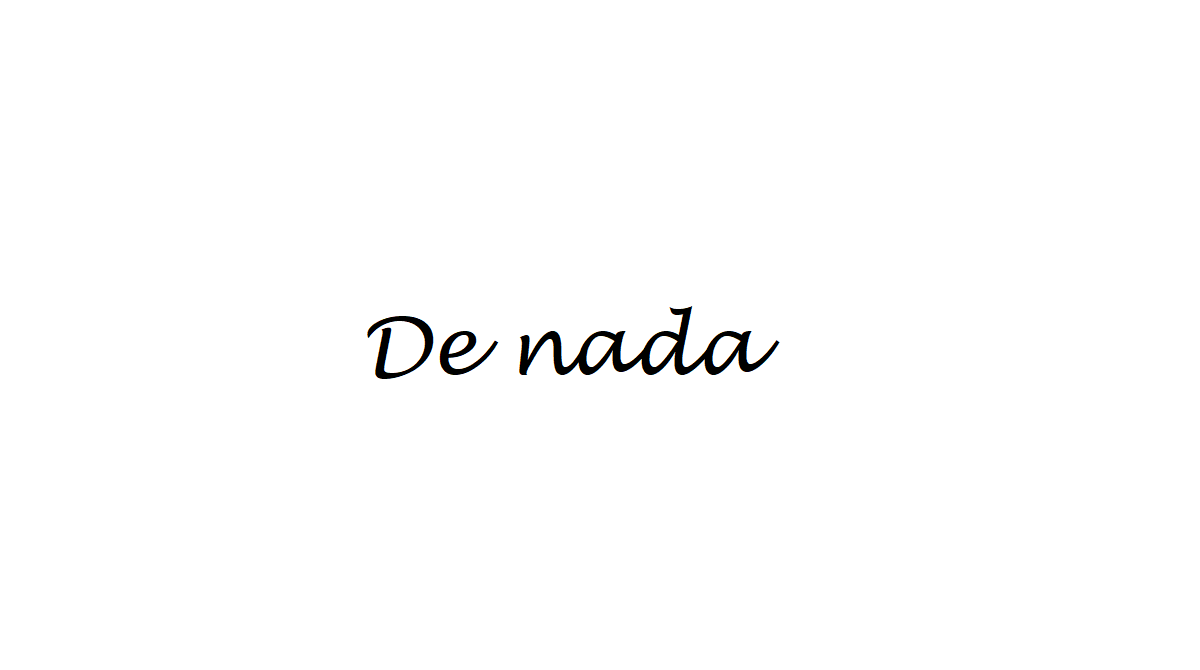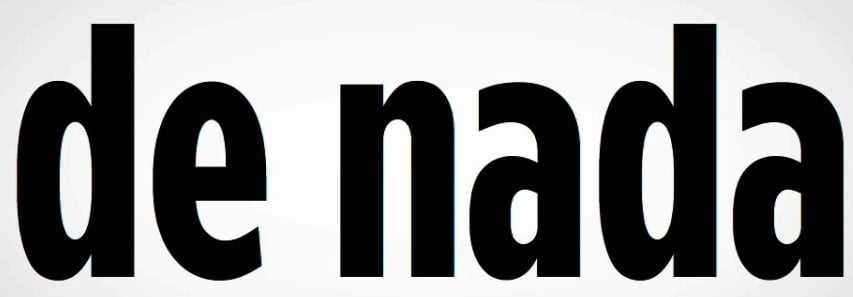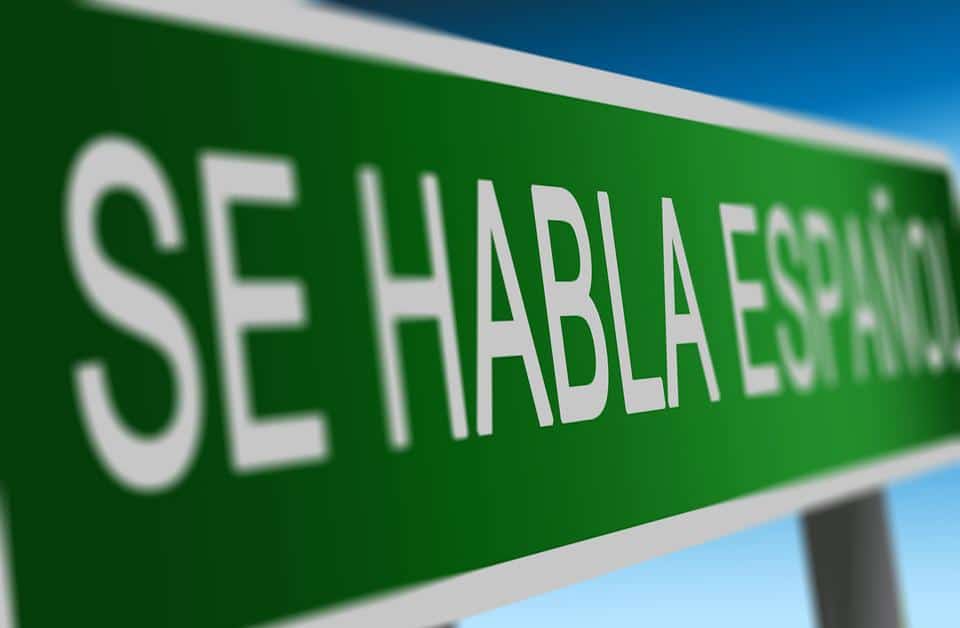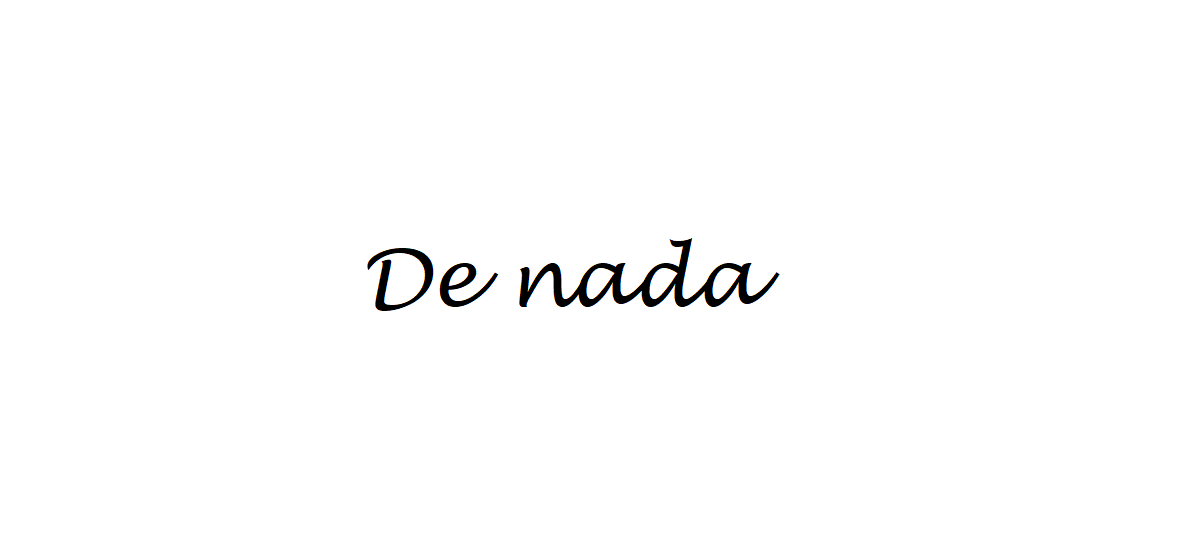How To Say You’re Welcome in Spanish
De Nada – This is the most popular way to say your welcome in Spanish. When translated to English it means “it’s nothing”. However, there are several other phrases one can use to express the same gratitude. De nada is by far the most popular saying in Spanish, but in other parts of the world, here are some other ways you can say You’re Welcome.

Por Nada – This is used less often, but still roughly translates to “for nothing”. In Spanish it is another way to say your welcome.
No Hay De Qué – You may hear Spanish speaking countries use this phrase in more formal settings. It’s a politer way to say you’re welcome then De Nada. It doesn’t really translate well into English as it comes out to “nothing to thank for”.

a la orden – Another formal way to say you’re welcome and translates to “at your command”. This is a common saying throughout most Spanish speaking countries and often used when assisting someone. It is also often used when speaking to someone elderly as a sign of respect.
con gusto – Not as commonly used, but you may hear it from time to time. This phrase translates to “with pleasure”.
Spanish speaking countries pride themselves on good etiquette. You’ll never hear a conversation not begin with a greeting such as hello, good morning, or good day and end with thank you, good night, or see you later. This is pretty common in most countries so it shouldn’t surprise you that it’s proper to answer every thank you with you’re welcome. The nice thing is just like in English, there are so many ways on how you can say your welcome. I personally like to say no worries or my pleasure just to change up the pace.

Examples of how to say You’re welcome in Spanish
- You’re welcome here anytime – Eres bienvenido aquí en cualquier momento
- Of course you’re welcome to come with us – Por supuesto que eres bienvenido a venir con nosotros.
- You’re welcome to take a look around – Le invitamos a echar un vistazo alrededor
- You’re welcome. Don’t worry about it. – Eres bienvenido. No te preocupes por eso.
- You’re welcome to ask me any questions – Eres bienvenido a hacerme cualquier pregunta.
Other ways to say You Are Welcome in Spanish
- No es nada – Meaning “it’s not a big deal” and one of the most casual ways you may hear someone reply after a thank you. Often used between friends and family as it holds no formal meaning.
- No hay problema – Meaning “it’s no problem” and again a very casual and simple alternative way to say you’re welcome.
- No tienes nada que agradecer – Meaning “think nothing of it”. You probably won’t hear this being used too often, but the older generation particular in Spain does sometimes use this phrase as a polite way to say you’re welcome after being thanked.
- Es un placer – Meaning “it’s my pleasure”. The hospitality industry will often say this to guests who thank them for carrying the luggage, serving them at a restaurant, or even opening a door at a hotel.
- No te preocupes – Meaning “no worries”. Another casual way to say you’re welcome between close friends.
- Con gusto – Meaning “happy to help”. A very polite response to someone who thanks you.
1) De nada – This phrase literally translates as “of nothing,” but it means “you’re welcome.” It is probably the most common way to express appreciation when someone thanks you in Spanish-speaking countries.
2) Por supuesto – This phrase directly translates as “of course.” It implies that what was done was no big deal and expresses an attitude of humility towards the person who thanked you for your help or service.
3) Con mucho gusto – This phrase literally translates as “with much pleasure,” and implies that whatever action was taken was not only appreciated but also enjoyable for the speaker.
4) No hay de qué – This phrase literally translates as “there’s nothing from which,” suggesting that there’s no need to thank because what has been done was insignificant or expected of any normal person in such circumstances.
5) A la orden –This expression literally means “at your order” and implies servitude on behalf of the speaker; they are at their recipient’s disposal should they ever need anything else from them again!
6) Claro que sí – The literal translation of this expression is “clearly yes,” though its meaning more closely resembles an enthusiastic affirmation than a simple agreement; essentially implying that whatever help has been given will always be gladly provided!
7) Encantado/a –This word directly translates into English as “enchanted,” indicating delight at being able to provide assistance!
8) Es un placer– Literally translating into English as “it’s a pleasure,” this response conveys joyfulness at having had an opportunity to lend aid!
9) Estoy para servirle –The direct translation here would be something along the lines of “I’m here (or available) to serve.” Though perhaps more formal than some other options on this list, it still gets across one’s willingness and enthusiasm about providing assistance whenever necessary!
Make sure you also brush up on some other popular phrases before visiting a Spanish speaking countries. Learning how to say “you’re welcome” is just one of roughly 20-25 works you should learn to fit into their culture and have a conversation worth while. The most important thing is everyone will be grateful you give an effort by just trying to be a part of their heritage.
History of You’re Welcome in Spanish
Not only in Spanish speaking countries, but all over the world the polite response from someone thanking you dated all the way back into the middle ages when it was more meant as agreeing with someone or finding something pleasing. As time went on the phrase “you’re welcome” shifted around the 15th century and was then thought to be used as giving someone permission to do something. Ex. “Here are some candies. You’re welcome”. Not until the 19th century did this phrase start being translated into a more polite form of greetings which we know today. Countries like Spain are very rich in their cultural values so saying you’re welcome after someone thanks you is customary and considered rude if you don’t reply.
In Spain, thanking someone and replying with a “you’re welcome” is very important in day-to-day interactions. It is seen as a sign of politeness and respect, indicating that the speaker values the interaction they are having with the other person. This practice has been around for centuries, so it runs deep in Spanish culture.
When people say thanks or you’re welcome to each other in Spain, it symbolizes mutual respect between two individuals. It’s an expression of gratitude for something done or said by one person towards another—whether it be an act of kindness or simply saying hello—and serves as recognition of their effort to make the conversation pleasant and enjoyable. The phrase “gracias” (thank you) can also be used when one wishes to thank someone for something specific such as a gift or favor given; however, more often than not its use is just general politeness among Spaniards who are engaging with each other on a daily basis. As such, even if there isn’t anything specific being thanked for at any particular moment, Spaniards will still take time to express their appreciation through this phrase before continuing on with their conversations.
Thanks and You’re Welcome have become ingrained into Spanish culture over time due to its importance in expressing cultural norms like courtesy and respect for others – both verbalized through words but also shown through body language like nodding your head or bowing slightly upon greeting someone new – which helps foster strong relationships amongst friends, family members and colleagues alike. Furthermore these phrases serve as reminders that everyone should strive to treat others kindly regardless of how well they know them because ultimately we all benefit from living in harmony rather than disharmony within our communities!
Therefore when people say “thanks” or “you’re welcome” in Spain they do so out of tradition but also out of genuine appreciation for one another; after all every kind gesture deserves acknowledgment no matter how small!
Ready to Say You’re Welcome in Spanish? – In Spanish
Cuando alguien te dice “gracias” en español, hay muchas maneras de responder con una respuesta educada y amable. Puedes decir “de nada” o una frase más larga como “no hay de qué”. Aquí están algunas formas divertidas y creativas para decir “de nada”:
1. Con mucho gusto – Esta expresión es tan simple como parece; significa literalmente que hiciste algo con placer. Es un modo cortés de decirle a la persona que has hecho algo encantado.
2. A tu servicio – Esta expresión se usaba antiguamente para indicar que estaban disponibles para servir a los demás en cualquier necesidad, lo cual todavía se considera apropiado hoy en día cuando agradecen por su ayuda o apoyo.
3. No hay problema – Un clásico entre los hispanohablantes, está frase significaría literalmente ‘no hay problemas’ pero también se refiere a ‘No fue ningún trabajo’. Se utiliza para indicar que eres amable y comprensivo incluso si no ha sido realmente un gran esfuerzo o inconveniente el ayudarte a otros.
4. Por supuestísimo – Está palabra cortante indicaría claramente tu disposición y deseos de ser útil sin importancia el tipo de ayuda ofrecida por otros..
5 .Por favor – Estamos acostumbrados a escucharlo cuando pedimos algo pero “por favor” también puedes usarse comúnmente después del “gracias” si quieres mostrar sincera gratitud por la atención recibida..
6 .Claro – Si quieres mantener las cosas simples, Claro siempre funciona bien ya sea verbalmente o escrito (comunmented usado en chats). La palabra implica que concediste la solicitud rápidamente sin pensarlo dos veces ni sentirlte obligado(A)..
7 .Fue mi placer – Este es particularmenteen adecuado si le has dedicado bastante tiempo o energia para complaer la peticion recibida ya sea grandiosaa pequeña..
8 .Con muchisimo gustooo – Si deseas exagerara tu respustta ,este podria ser el perfectoo Camino ..
9 .De NADA!- El mas popular y sencilloo De Todoss Los Tiempos!!
There are several other ways you can also say “you’re welcome” in Spanish, but these are some of the more popular ways. Learn also how to say thank you in Spanish.


 Hello in Spanish
Hello in Spanish